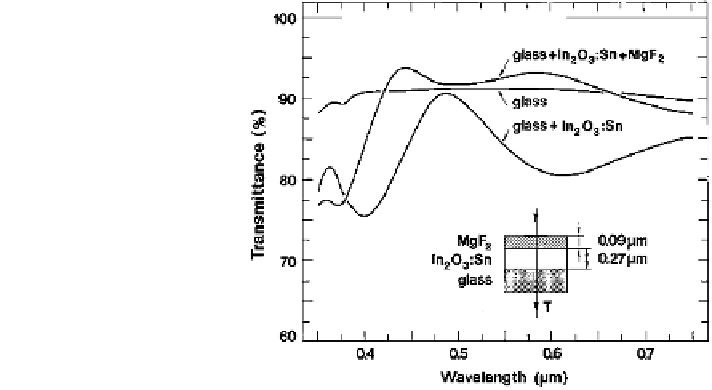Civil Engineering Reference
In-Depth Information
2.4 Transparent Conducting Thin Films: A Survey
Transparent electrical conductors are essential for electrochromic devices and may
be their most expensive individual components. There are several types of trans-
parent conductors, comprised of different materials and having different properties
(Granqvist
2007
; Ginley et al.
2010
) as discussed below.
Heavily doped wide band-gap oxide semiconductor oxides are often used in
electrochromic devices. The most common materials are In
2
O
3
:Sn (indium tin
oxide, ITO), ZnO:Al (AZO), ZnO:Ga (GZO), ZnO:In (IZO), and SnO
2
:F (FTO), and
the doping level is a few percent. All these materials can have a resistivity as low as
*1 9 10
-4
Xcm, a luminous absorptance of only a few percent in a *0.3-lm-
thick film, and very good durability. The optical properties are well understood
(Hamberg and Granqvist
1986
; Jin et al.
1988
; Stjerna et al.
1994
), and hence,
modeling of the optical performance can be done reliably. Films of ITO, AZO, GZO,
and IZO made by carefully controlled sputter deposition onto glass and PET typi-
cally show resistivities of *2 9 10
-4
and *4 9 10
-4
Xcm, respectively
(Granqvist
2007
). High-quality FTO films can be made by spray pyrolysis onto hot
glass emerging from the leer during float glass production. All the mentioned oxides
have a high value of T
sol
. Concerning T
lum
, antireflection-coated ITO can be more
transparent than uncoated glass (Hamberg and Granqvist
1986
), as shown in Fig.
9
.
ITO films can be more expensive than the Zn-based and Sn-based alternatives
as a consequence of the high price of In metal [despite its relative elemental
abundance in the earth's crust (Schwarz-Schampera and Herzig
2002
)]. Another
possibly limiting factor for ITO may be the newly reported danger of thin-film
deposition leading to pulmonary disorders (Omae et al.
2011
).
Extremely thin continuous metal films—especially of the coinage metals Cu,
Ag, and Au—can serve as excellent alternatives to the heavily doped wide
band-gap semiconductors (Granqvist
2007
; Lansåker et al.
2013
). Their electrical
Fig. 9 Spectral
transmittance T for an ITO
film on glass before and after
antireflection treatment with
an MgF
2
layer having
optimized thickness. From
Hamberg and Granqvist
(
1986
)

